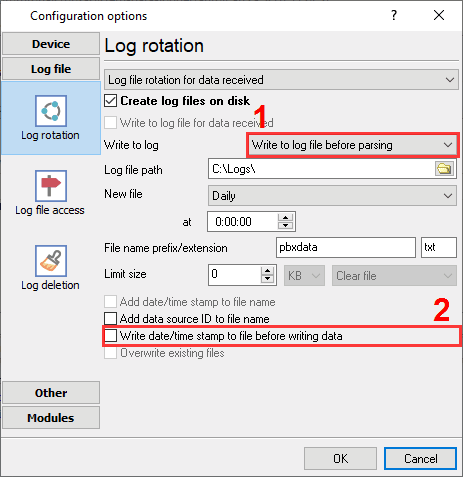How to configure logging to a file before parsing
When you're setting up PBX Data Logger, a clean, unaltered log file is often your best safety net. You need a log file when you're diagnosing connection issues, verifying what the PBX is actually sending, or preparing to parse data later with scripts or third-party tools. It's the authoritative record of raw input, letting you confirm formats, timestamps, and full message content before any processing happens.
In emergencies-like unexpected call drops, billing disputes, or security incidents-raw logs help you reconstruct events fast. You can trace call flows, correlate messages across systems, and provide evidence that stands up to audits. Because the data is complete and time-aligned, you can identify the moment something went wrong and the surrounding conditions. The logger can also restore some records in a database from log files if you accidentally deleted it.
You want log files without any modifications to avoid losing context or introducing mistakes. Filters, formatting, or transformations can hide fields, change order, or alter values-making troubleshooting harder and evidence less reliable. Capturing the original stream preserves integrity, ensures reproducibility, and keeps your options open for any downstream analysis or tooling.
1. Open the configuration settings in the "Main menu → Options → Manage configuration → Your configuration → Edit" menu.
2. Go to the "Log files → Log rotation" tab.
3. Configure the log file settings as shown below. The program will create a new log file every day. Of course, you can select another folder for log files.

Figure 1. Log file settings
Related articles: How to configure logging to a file before parsing
- How to install PBX Logger with ODBC Database (required for PBX Reports).
- How to configure logging to the database using the ODBC Database module (manually, for new connections).
- How to configure logging to the database using the SQL Database Pro module.
- How to create an ODBC data source.
- Check the parser's operation.
- Log additional data from your PBX.
- How to view data in PBX Reports.
- Possible problems when the program is running as a service.
- Use Advanced PBX Data Logger as middleware between a PBX and another information system (PMS or CRM).
- Connect modern IP PBX to CheckInn and PhoneMon using PBX Logger.
- How to configure logging to a file before parsing.
Related topics: Advanced PBX Data Logger
hereCall logging Call accounting SMDR to SQL SMDR Listener Cables and signals